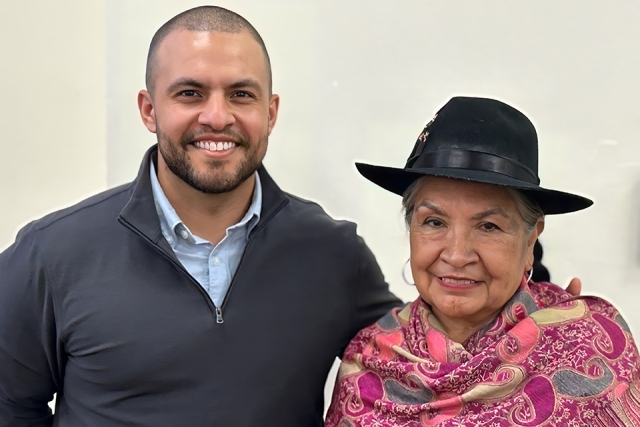
Pablo Sanchez ’13C, ’14G, ’19GCCPS, Adjunct Professor, Sociology and Anthropology at St. John’s College, with Tarcila Rivera Zea
In few places have the local population been as active in pushing back against environmental change as in the mountainous areas of Peru and Bolivia, home to the indigenous Quechua people.
According to Quechua-born activist Tarcila Rivera Zea, the people push back out of necessity.
“The solutions offered were not appropriate for the environment in which we live,” Ms. Rivera Zea told a gathering of St. John’s University students, alumni, faculty, administrators, and staff on March 18 in the latest discussion in the Vincentian Chair of Social Justice 2023–24 environmental justice lecture series.
“After many years of trying to discuss with the scientific community what is happening in our region and what changes we are observing, we concluded that the solution cannot come from that community alone,” Ms. Rivera Zea continued. “We are not the focus of their attention. We began to see indigenous knowledge as a possible solution.”
Scattered among the Andes Mountains and along the Amazon River, the Quechua people number about 10 million. They are among the descendants of the Inca Empire, which ruled South America a century before the arrival of the Spanish. Today, most rely on subsistence farming of corn, potatoes, and other high-altitude crops for their livelihood.
Because land is still farmed in the Inca tradition of terracing, heavy rains can wash away an entire year’s harvest. Likewise, changes in rainfall patterns, drought, and rising temperatures threaten potato and orange crops.
Describing the Quechua as naturally self-sufficient, Ms. Rivera Zea said her people traditionally have manufactured ways to protect their harvests. But two decades of unpredictable weather have left them vulnerable.
According to the United Nations, the majority of Quechuans lack running water and live below the poverty line, earning less than $10 per day.
“We here in our country might not understand how much of a process it is for people in this environment to survive,” said Julia Bonanno ’23C, who is pursuing a doctoral degree in School Psychology in The School of Education. “If we can raise awareness about this and other things, maybe we can make some good things happen for them.”
The theme of the 2023–24 social justice lecture series, “Cry of the Earth, Cry of the Poor,” reflects the disproportionate impact felt by the disadvantaged as climate conditions change and development efforts gain support. Prior lectures have shown how people experiencing poverty in India face competition for drinking water and other essentials. Rebuilding after five years of drought, the needy in Kenya now confront food insecurity and associated diseases.
The latest lecture in the series included a discussion of how Quechuans have insulated themselves against the impact of climate change.
Fish farms and other aquacultural initiatives have built up food reserves. Perceptive farmers learned several years ago how to mitigate the impact of parasites on potato and corn harvests. Crop rotation has helped to preserve essential nutrients in the soil.
“It’s inspiring to see how the people have tried to develop bottom-up solutions,” said Sarah Quispe ’23C, who is pursuing a Master of Arts degree in Criminology and Justice at St. John’s College of Liberal Arts and Sciences. “They can be more lasting than solutions from the top of government. The people hit the hardest by climate change can have the most creative solutions.”
Ms. Rivera Zea has participated in numerous global forums on indigenous issues, including several on the impact of climate change on indigenous populations. She is a former member of the United Nations Permanent Forum on Indigenous Issues, and in 2011, received a Ford Foundation Visionaries Award for her work in creating the International Forum of Indigenous Women of the Americas.
She said that climate change has compromised several health and social practices of the Quechuans. With that can come the potential for tension in the community.
“When people are looking for water or food, the mother has to go find them,” Ms. Rivera Zea said. “The father has often gone to other parts of the country to look for work. The location of schools or internet access is not common for all people, so when we have extreme rain, people can become isolated.”
“Indigenous women also practice traditional medicine,” she continued. “But if you do not have sufficient rain, the medicine plants will not grow. When you do not have food, water, or medicine, what can happen? Violence.”
That has yet to happen, Ms. Rivera Zea said. Peru has received several grants for the Quechuans from the Green Climate Fund, the world’s most significant climate and economic support fund for developing countries. Sadly, the money does not always reach the local population.
“We have to be able to access the funds as an indigenous people,” she said. “We don’t always have that possibility because of conditions and intermediaries.”
In the meantime, the Quechuans continue to adapt to a changing environment.
“There is so much dialogue around finding new kinds of solutions to climate issues,” said Pablo Sanchez ’13C, ’14G, ’19GCCPS, Adjunct Professor, Department of Sociology and Anthropology at St. John’s College and Senior Data Scientist at The Hunger Project. “We stand to learn a great deal from their knowledge and how they have applied it.”
